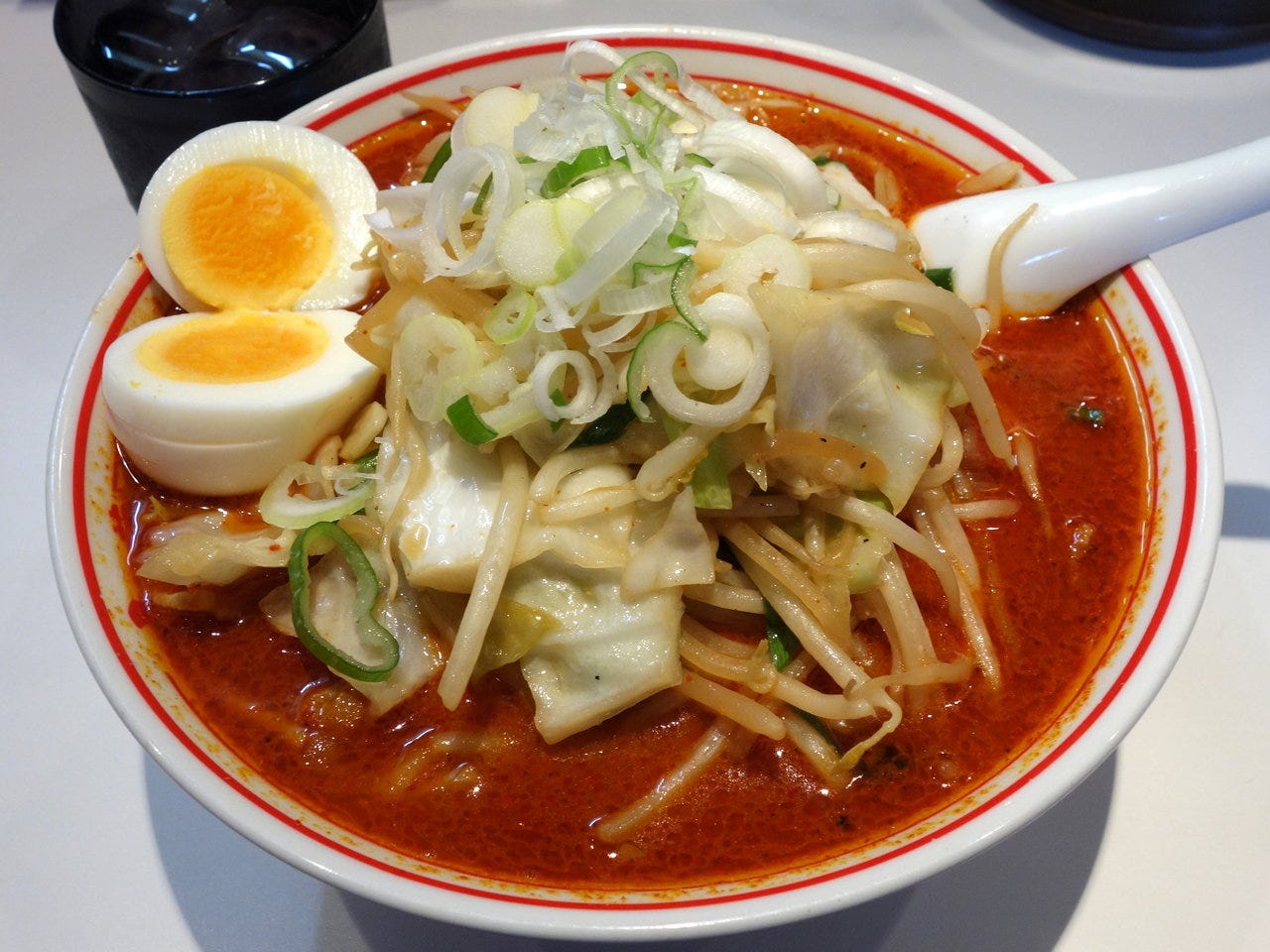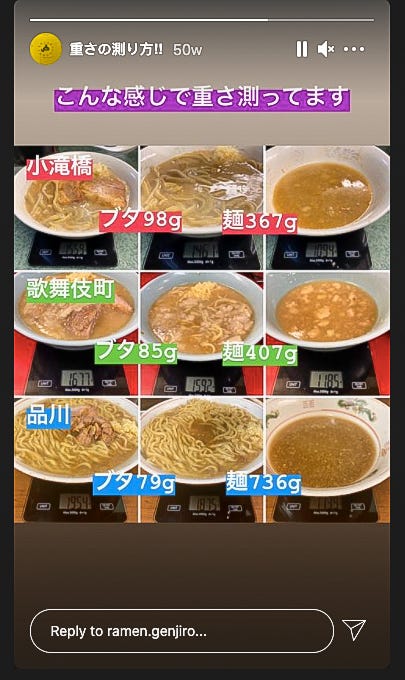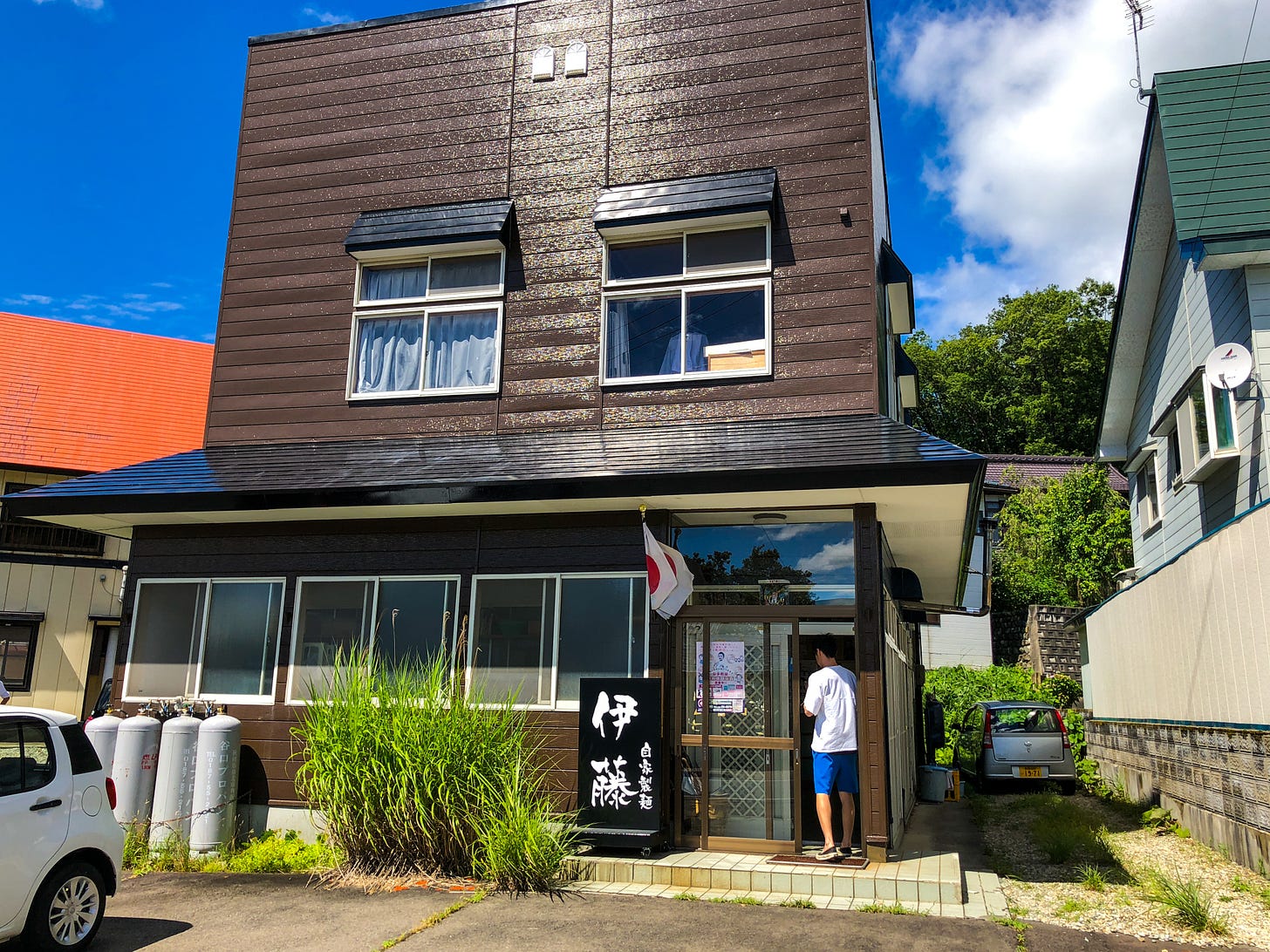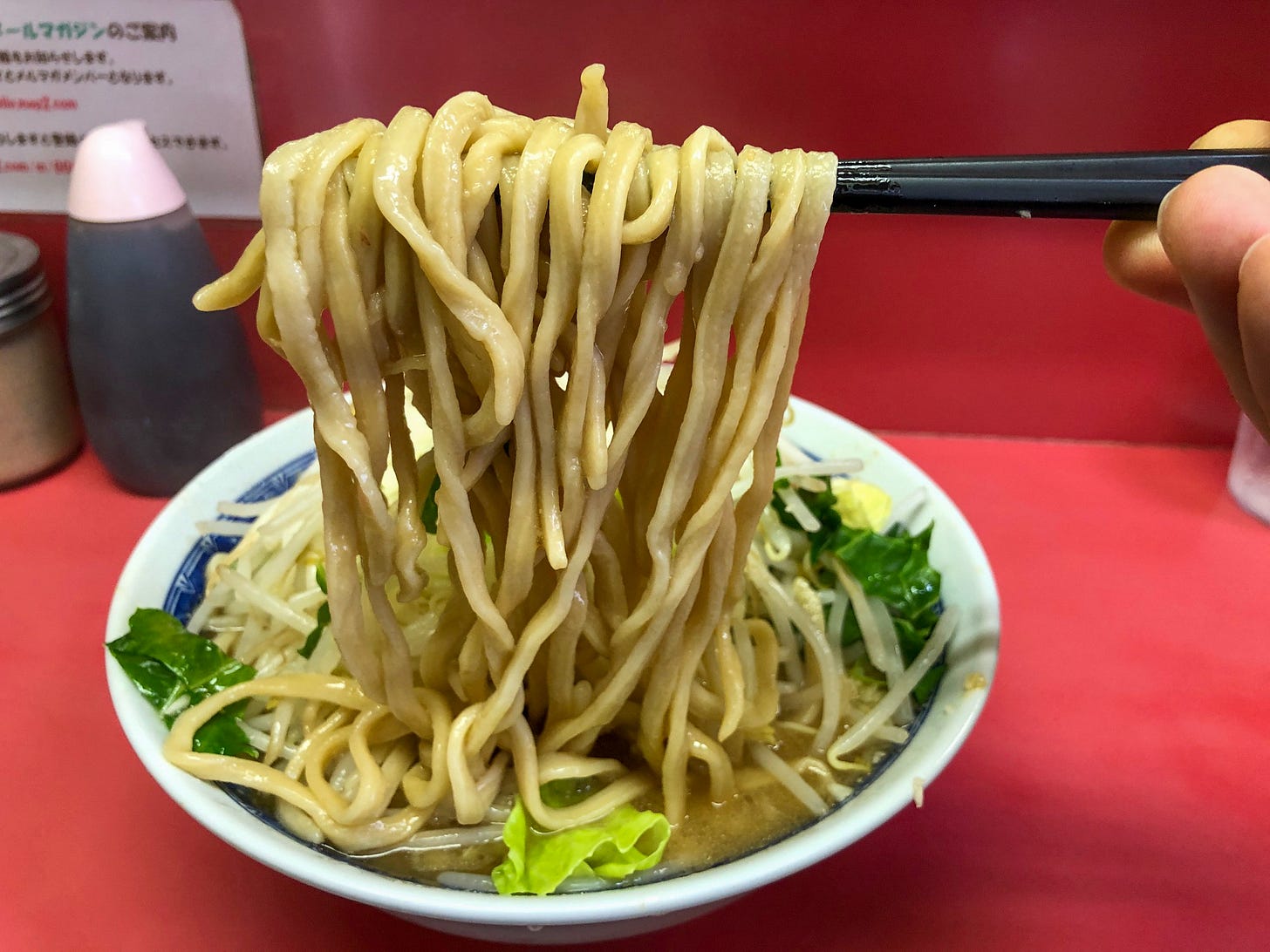This week’s Ramen Beast dispatch is all about the treasure map that guides the hunt — the ramen head hit list.
If this is your first time checking us out, this is the Ramen Beast Newsletter, where we share stories and street-level expert intel from Japan’s vast ramen subculture. Subscribe or share below, and if there’s a ramen topic you’d like us to tackle in a future edition, shoot us an email.
►Ramen Hit Lists: The Allure & Absurdity
Like hardcore collectors of all kinds, ramen hunters tend to have ambitious checklists that structure and drive their pursuit. Think sneaker heads, bird watchers, or wine and whisky collectors — same game, different obsessions.
Within Japan's ramen scene, there are various unofficial challenges, or checklists, that carry currency. For example, having eaten at all 41 locations of the cult ramen chain Ramen Jiro, which is spread across the entire country with each shop serving a slightly different version of the brand's infamously salty, porky, MSG-heavy signature dish. Or eating every bowl on Tabelog's Top 100 Ramen lists, which are updated annually and feature 100 top-ranked shops for Tokyo, 100 for East Japan and another 100 in West Japan (Tabelog is generally considered Japan's most influential restaurant reviews site). Other hit lists are more personal, and obscure. Just as some varieties of wine have their own diehard devotees, some ramen eaters attempt to "master" a particular genre, eating as many shops in that style as possible, studying slight nuances of ingredients and preparation, and learning about the lineage of master-apprentice training that links the various shops. Not surprisingly, many of the most coveted targets are shops or challenges that are especially inaccessible, or that require obscure knowledge to track down and understand (such as Rairai, the legendary shop featured in last week's Ramen Beast newsletter).
The Ramen Beast team recently sat down to share ramen hit list war stories, and to discuss the appeal, usefulness and occasional absurdity of such challenges.
Patrick: What are the ramen targets / challenges / checklists that you are currently chasing and how close are you to achieving them?
Cody Mizuno: The biggest checklist I've been working on for the past year is the Ramen Jiro list. I'm currently at 36/41 with just five shops remaining. Another which I've been intermittently working on is the Marucho/Marushin Noren-kai list, which is a group of ramen shops which originate their training at Marucho in Ogikubo, a legendary shop that is credited with co-inventing tsukemen. I have about 10 of 40 of the Marucho disciples checked off — so that will definitely be taking up the bulk of my ramen eating in 2021. I just finished the Michelin Guide list of Tokyo which was more out of curiosity rather than a true desire to finish it off, but I guess you could say that it falls within the same category. Same goes with the Tabelog Top 100 for Tokyo, which I'm completing more as a reference for myself rather than a challenge. I'm curious what these so-called food experts consider to be the best ramen of Tokyo, and to compare and contrast with my own opinions about those shops.
Abram Plaut: I guess at the top of my hit list for 2021 also is finishing every Ramen Jiro. I'm at 39 of 41 with two to go. I'm also working on finishing the Tabelog Top 100 lists for 2020, which includes Tokyo (100/100), East Japan (95/100) and West Japan (59/100). Those remaining 50+ shops will involve trips all over the country — it will take months.
After you've hit these goals, what do you see yourself pursuing next?
Abram: There are so many pursuits, it's endless. There isn't one thing that stands out, but in general learning about and trying all of the many regional ramen styles is appealing to me. The shops in the countryside go so deep. There are at least 100 unique regional styles, some in very remote parts of the country. But at the same time, it's crazy when you remember that a few hundred new ramen shops open each year just in the greater Tokyo area. Trying to keep up with the best new shops in Tokyo each year is enough to break the spirit of most men. A lot of my hit list, which I keep on my phone, is just a running compendium of 30-60 new shops that I’ve recently read about, heard about, or somehow been tipped off to — and need to check out.


How about you, Cody? What’s next?
Cody: So after finishing the 41 Jiro locations, my focus will probably shift primarily to the 40 Marucho/Marushin Noren-kai list. And like many Jirorians, as soon as I’ve hit every standard bowl, or first menu item, at all of the Jiro shops, I’m going to immediately start over and begin tackling the secondary menu item at every shop. This should take me a year or two. [Laughs] I will also be working on having the special, gentei menu items of every Mouko Tanmen Nakamoto location in Japan. This is another chain that has a passionate fan culture here in Japan. Each shop location usually has specific special items you can only get at that location — so a lot of spicy ramen in store for 2021.

What are the challenges that impress you the most if you meet a ramen head and they tell you about their eating history?
Cody: To be honest, rather than the challenge itself, I'm more curious in the story behind why a ramen eater is trying to accomplish said grail or checklist. It's usually something mundane like finishing the Tabelog Top 100 just for the sake of it, but sometimes you hear something out of left field, such as, say, eating at every shop that involves the training lineage of a specific chef, or flavor profiles of a specific ingredient — those stories usually inspire me to try to accomplish the feat alongside them. Often when I ask someone what's on their ramen hit list and why, this leads to some of the most interesting ramen conversations I'll have. For me, it’s usually just about trying to learn and understand more about this unique food subculture and its history, because like Abram said, it’s truly endless.
I will say though, the feat I was most impressed with was a local Japanese blogger, whom I can't seem to find right now, who ate at every single "Ramen Shop" location in Japan and wrote about it. For those who are unaware, Ramen Shop is a ramen franchise that serves essentially the predecessor to Iekei ramen. The ramen typically consists of yellow ramen noodles in a creamy, fat-heavy soup of pork and chicken with naga negi used as a popular topping. There are over 300 shops throughout Japan and that blogger ate at every single one of them over the course of three years, giving a detailed, comparative review for each one. This was probably the one and only time I was totally impressed with a ramen eating feat, given how difficult each shop is to find, yet alone visit.
Abram: It's not like there's one answer to this — each situation is different and people do so many different crazy things. Recently we found this guy on Instagram who eats at all the different Ramen Jiro shops and lists the exact weight of the components for the bowl served by each shop — the weight of the chashu, noodles, etc. for every single visit he makes. How does he do it? He takes a scale with him and weighs the ramen — literally puts his scale on the counter and places the bowl of ramen on top. Then he eats the ingredients one at a time to check the weight difference, so that he can calculate how much of each ingredient is in the bowl. Who goes to these lengths!? This is serious nerd shit. But it’s kind of impressive to me…!

So what's the appeal of these challenges for you guys?
Abram: No matter what field you are in, I think you just want to learn and know as much as possible. Master your craft, right? In the case of ramen, that means a lot of eating. Ramen is awesome, so it's appealing. For me personally, there's an extra sense of gratification that comes with completing these lists or challenges, knowing I'm part of this special world that is so exclusive and difficult to become a part of and understand — especially if you aren't Japanese. Many of these lists can take not months but years to complete. Just the challenge of it (as a foreigner) makes it extra special to me.
Cody: For me, especially with the Ramen Jiro challenge, the appeal comes from the community of fellow ramen heads; in this case, Jirorians. Jirorians, or hardcore Jiro fanatics, are some of the most maniacally obsessed people I've ever had the pleasure of meeting and chatting with. I'm currently in a chat community where people would post photos of their Jiro bowls and before they can even describe their experience, people would correctly guess which shop location the bowl was from (For those not in the know, all Jiro locations essentially serve the exact same dish, just with very minor differences in preparation or topping options from location to location). Being able to talk about what we like and what we didn't like about each shop after trying the different locations is what I enjoy most. Just how informed this community is about this subculture.
I have a background in wine as my mom is a Sommelier and it's a bit like learning to blind test. Having these countless flavors in your memory and backlog helps you deduce how each bowl is prepared and gives you a better overall picture of how these Jiro bowls and chefs are interconnected. Filling in this painting with more colors keeps me excited and motivated to "finish." Of course, finish is theoretical as Jiro is known for Bure, or flavor variations in the soup between days of operation, so it'll likely be a lifelong obsession of continuous Jiro eating with no real end in sight.
With Marucho, it's more about learning the history behind how the numerous shops became Noren-wake, and which specific shop their lineage tree runs through. For sports fans, I equate it to an NFL coaching tree. Much like Belichick of the Patriots has trained both good and bad NFL/College coaches, Marucho has done the same for the ramen industry training countless chefs along the way. My enjoyment comes from experiencing each "coaching" style and seeing how similar and different they are.
What role would you say these lists play in the ramen head world?
Abram: Well there are so many ramen shops — thousands — so having lists or challenges is just a great way to categorize and sub-categorize. Organizing data, making the hunt fun and comprehensible.
Cody: Yeah, I think in that sense, sharing these lists gives other ramen enthusiasts a way into learning more about specific ramen styles, many of which have pretty complicated histories. But other than that, it's a bit like every other hobby where "collecting" is involved. Whether it be wine, sneakers, retro games or whisky, they all use so-called lists to both inform others in their hobby circle, or just to have an easily sortable and aesthetically appealing list to "show off" their collection. That's probably why a lot of these collectors are big into instagram as well, myself included.
Do you think there is a Japanese cultural aspect to this phenomenon?
Abram: Yes, I think so.
Cody: I'm not ready to say it's Japan specific, but we Japanese are known to be quite obsessive when it comes to our hobbies, so it might have something to do with it [Laughs].
Give us an example of something arduous or ridiculously inconvenient you did just to check off a shop.
Cody: So I guess I have a sort of "Niboshi Grand Canyon" checklist of shops which are known in the ramen industry to be the top tier of Niboshi style ramen. In 2020, I was able to visit an OG, founding father of the style in Akita at a shop called Jikaseimen Ito, which was definitely a milestone achievement for me. Ito-san has a brother and nephews who have opened locations in Tokyo, but being able to have a bowl from the source in a small town in Akita was definitely more difficult and time-consuming — and memorable. For those who don't know, Akita is on the far northern side of Honshu.


Abram: I've been to that shop too by the way, it's wild. I feel like I am doing ridiculous things all the time. Just trying to finish all 41 Jiro shops is ridiculous. The other day I went to Ramen Jiro in Aizu Wakamatsu, Fukushima. I left home around 9am, spent one hour on the train to Omiya, caught the bullet train to Fukushima Prefecture, took bus to Aizu-Wakamatsu, and walked 20 minutes to the shop. I finished eating in 15 minutes, turned around and went straight back to Tokyo, arriving home around 6pm. This was to eat a bowl of Jiro Ramen, which I can get at dozens of other locations around Tokyo — but this one was slightly different, and I needed to check it off.
If some of this discussion sparked your curiosity about the cult that is Ramen Jiro, keep an eye out for next week’s edition, in which we will provide the Ultimate Ramen Jiro Guide, unpacking the history, code words and mysterious, gut-busting appeal of Japan’s most infamous ramen shop.





Enjoyable content. Always nice when friends share their passion and look out for each other in ramen and life!